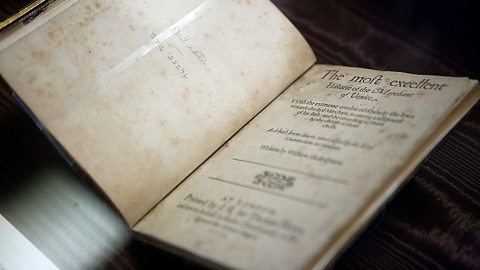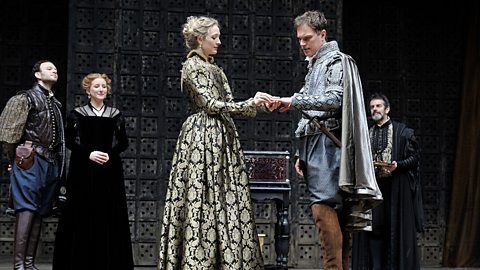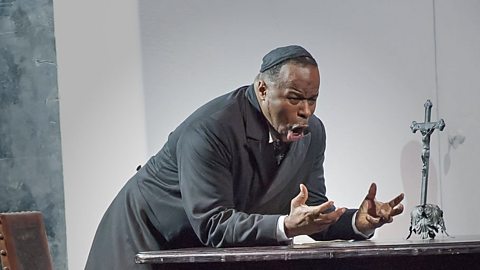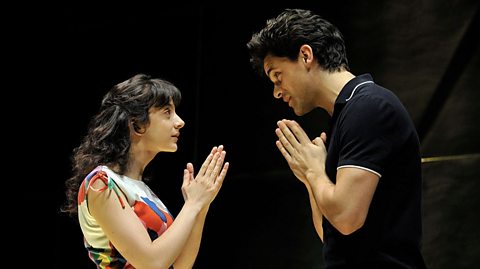Key points

Shakespeare's The Merchant of Venice is a play in five acts. The action moves chronologically.
This is a typical Shakespearean structure that builds the drama to a climax or important turning point.
It is written in blank verse and prose.
It contains elements of tragedy and comedy.


Remember
When you identify a point about form, structure or language, you should always explore the effect and consider why the writer chose that technique.
Form
A play

The Merchant of Venice is a play and so is intended for performance. Listening to actors perform the lines brings a play to life.
Novels often describe settings in detail and provide information about the physical appearance and psychology of their characters. They can be read at whatever pace the reader chooses.
In contrast, a play’s setting and its characters are open to the interpretation of its director and actors. A play is also a real-time event that is experienced differently by each member of the audience.

Tragi-Comedy
The Merchant of Venice was categorised as a comedy in Shakespeare’s time. However, it has two distinct plotlines:
- The romantic comedy of Portia, Bassanio and the caskets (which includes the mix-up with the wedding ring at the end).
- The bloodthirstyCruel and barbaric. bargain which almost leads to Antonio’s downfall and has tragic consequences for Shylock.
The play has features of Shakespearean comedy such as disguises, misunderstandings, jokes and wordplay.
But it also has features of Shakespearean tragedy such as a focus on revenge, good and evil.
The combination of comedy and tragedy, and the play’s portrayal of antisemitismAntisemitism is a type of prejudice or discrimination towards Jews individually or as a group. It is based on unfounded stereotypes that target Jews as a people or their religious practices and beliefs. are aspects that have led it to be called a “Problem Play”.
Verse and prose
The Merchant of Venice is written in a combination of blank verse and prose.
Blank verse
Blank verse is made up of unrhymed lines with a particular rhythm or meter. The majority of The Merchant of Venice is written in blank verse.
Most of Shakesepare’s blank verse is called iambic pentameter. The rhythm in iambic pentameter is made up of ten syllables per line. The ten syllables are organised in five pairs. The first syllable is weak or unstressed, the second is stronger. This makes the verse sound like a heart beating.
In this example from The Merchant of Venice, the stressed syllable is shown in bold:
“In sooth, I know not why I am so sad”
Question
When and why do characters use iambic pentameter?
1. When they are passionate
When characters are full of passion, fury or other strong emotion, they tend to speak in iambic pentameter. Portia’s speech about the quality of mercy, which she gives at the trial when trying to save Antonio’s life, is a passionate speech written entirely in iambic pentameter.
2. When they are in tune
Sometimes, characters finish off each other’s iambic pentameter. Jessica and Lorenzo do this at the start of Act 5, Scene 1
Jessica: And ran dismayed away”
Lorenzo: "In such a night.
The whole section is in iambic pentameter, but the last line of Jessica’s has six beats, which is then completed with Lorenzo’s first line of four beats. The fact that they can finish off each other’s ten-syllable rhythm shows how in tune with each other they are.
3. To provide a conclusion
Sometimes, when characters are speaking in iambic pentameter, Shakespeare finishes off their speech with a rhyming pair of final lines, known as a rhyming couplet.
This has the effect of summarising the main point of their speech, and often comes at the end of a scene, giving the audience a clear summary of what has just happened. For example, at the end of Act 2, Scene 3, Jessica tells Lorenzo:
If thou keep promise, I shall end this strife
Become a Christian and thy loving wife.
Prose
Not all of the play is written in iambic pentameter. About 20 percent of the play is written in proseA style of writing or speaking where there is no specific rhythm. It sounds like everyday language. . Prose does not have a definite rhythmical structure or meter.
Shakespeare often uses prose for characters who are lower status. So a king or queen would speak lines of iambic pentameter, whereas a servant might speak in prose. Launcelot Gobbo, Shylock’s comical servant, speaks in prose.
Question
When and why do characters use prose?
When characters are chatting about trivial things, they tend to speak in prose.
For example, when Portia and Nerissa first appear they speak in prose. This is probably because they are chatting informally about the different suitors that have visited Belmont. Their tone is light-hearted rather than passionate.
Prose suits this type of exchange better than iambic pentameter blank verse.

Remember
When answering an exam question, consider whether the extract given is written in iambic pentameter or prose.
Think about what that reveals about the characters, their feelings and relationships.
Mini quiz
Structure

The play is set out in five acts and told chronologically – in the order that the events happen. This is a typical Shakespearean structure that follows a pattern of building to a climax or important turning point – in this case, where Antonio is arrested and faces Shylock at the trial.
The structure of the play is made up of two separate plots. Shakespeare switches between the two plots.
Tension is created by leaving gaps between the scenes involving Shylock and Antonio’s bloodthirsty agreement.
The gaps are filled with Portia and Bassanio’s romantic comedy subplot which creates some relief from the tense drama, and builds anticipation.
The final Act sees Antonio freed, Shylock losing everything, and Portia and Bassanio reunited.

The five act structure in detail
1. Introduction
Act 1 - An introduction to all characters and their situations: Antonio is sad for no reason, whilst Bassanio needs his help.
Portia is in Belmont – will a suitable suitor choose the right casket?
Antonio and Bassanio strike a deal with Shylock regarding the loan and the pound of flesh.
2. Rising action
Act 2 and Act 3 – Portia is introduced in Belmont. Her unsuccessful suitors choose the wrong caskets and fail to solve the riddle to become her husband.
Shylock’s daughter Jessica plots with young Christian Lorenzo to escape from her father.
Bassanio solves the riddle of the caskets allowing him to marry Portia, but disaster strikes for Antonio when his ships are lost at sea.
Shylock learns of Antonio’s misfortune but also discovers his daughter has run away with Lorenzo.
3. Climax
The climax is the important turning point in the story that everything has been building up to.
Act 3 and Act 4 - Antonio is arrested and Portia forms a plan to secretly represent Antonio in court. Shylock and Antonio face each other in court.
4. Falling action
Act 4 – Portia appears disguised as a young lawyer and outwits Shylock. Shylock loses his wealth and his religion. Antonio is now a free man.
5. Resolution
Act 5 - A comical resolution involving Bassanio’s wedding ring, which he has given away to the lawyer. Portia’s identity as the lawyer is revealed. There is a happy ending for many of the characters.
Language
Analysing language
When writing about language, it is important to consider:
- Which language technique Shakespeare has used
- Why he chose this technique
- What effect this technique has on the audience.
Consider this extract:
"If you prick us, do we not bleed? If you tickle us, do we not laugh? If you poison us, do we not die? and if you wrong us, shall we not revenge? If we are like you in the rest, we will resemble you in that."
| Language technique | Rhetorical questions |
| Why? | Shakespeare uses rhetorical questions to give Shylock a voice to speak about the antisemitismAntisemitism is a type of prejudice or discrimination towards Jews individually or as a group. It is based on unfounded stereotypes that target Jews as a people or their religious practices and beliefs. he faces. 'Rhetoric' is the careful, planned use of language to persuade, motivate and influence. There are a number of rhetorical questions in this speech with the repeated pattern “If you…” and “Hath not…” These questions speak directly to the audience and the repeated structure emphasises Shylock’s point over and over again. |
| Effect | The audience is forced to confront their own prejudices. It helps the audience to sympathise with Shylock. He may be greedy and cruel, but the articulate way he explains his treatment makes the audience feel sympathy for him. |
Portia's speech
Portia gives a powerful speech about the quality of mercy. She tries to persuade Shylock that he should be merciful by arguing that mercy is good for both the giver and receiver and that it is a kingly and Godly quality.
Question
What do we call language that is intended to influence and persuade?
We call this type of language “rhetoric”. Another example of rhetoric in the play is Shylock’s powerful speech about prejudice – “Hath not a Jew eyes?”

Quiz
Test your knowledge of the language, structure and form of Shakespeare’s The Merchant of Venice by taking this multiple-choice quiz.
More on The Merchant of Venice
Find out more by working through a topic
- count1 of 5

- count2 of 5

- count3 of 5
